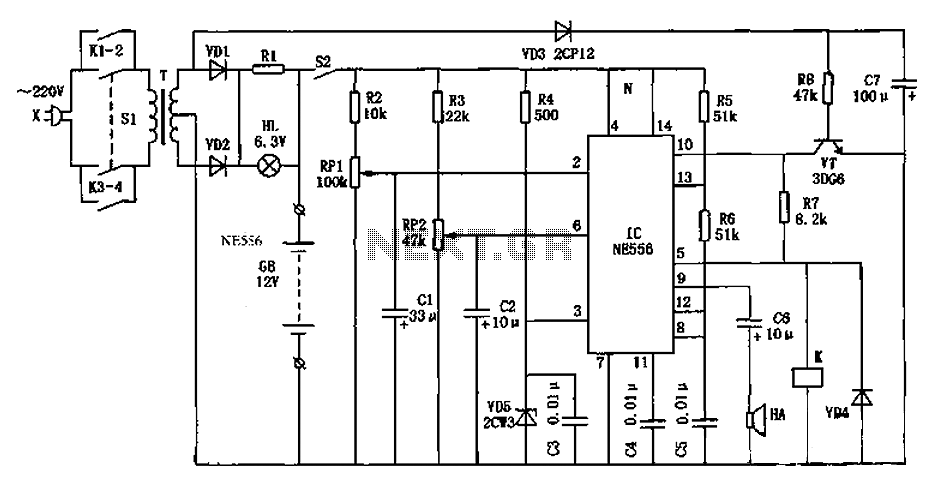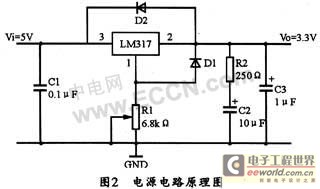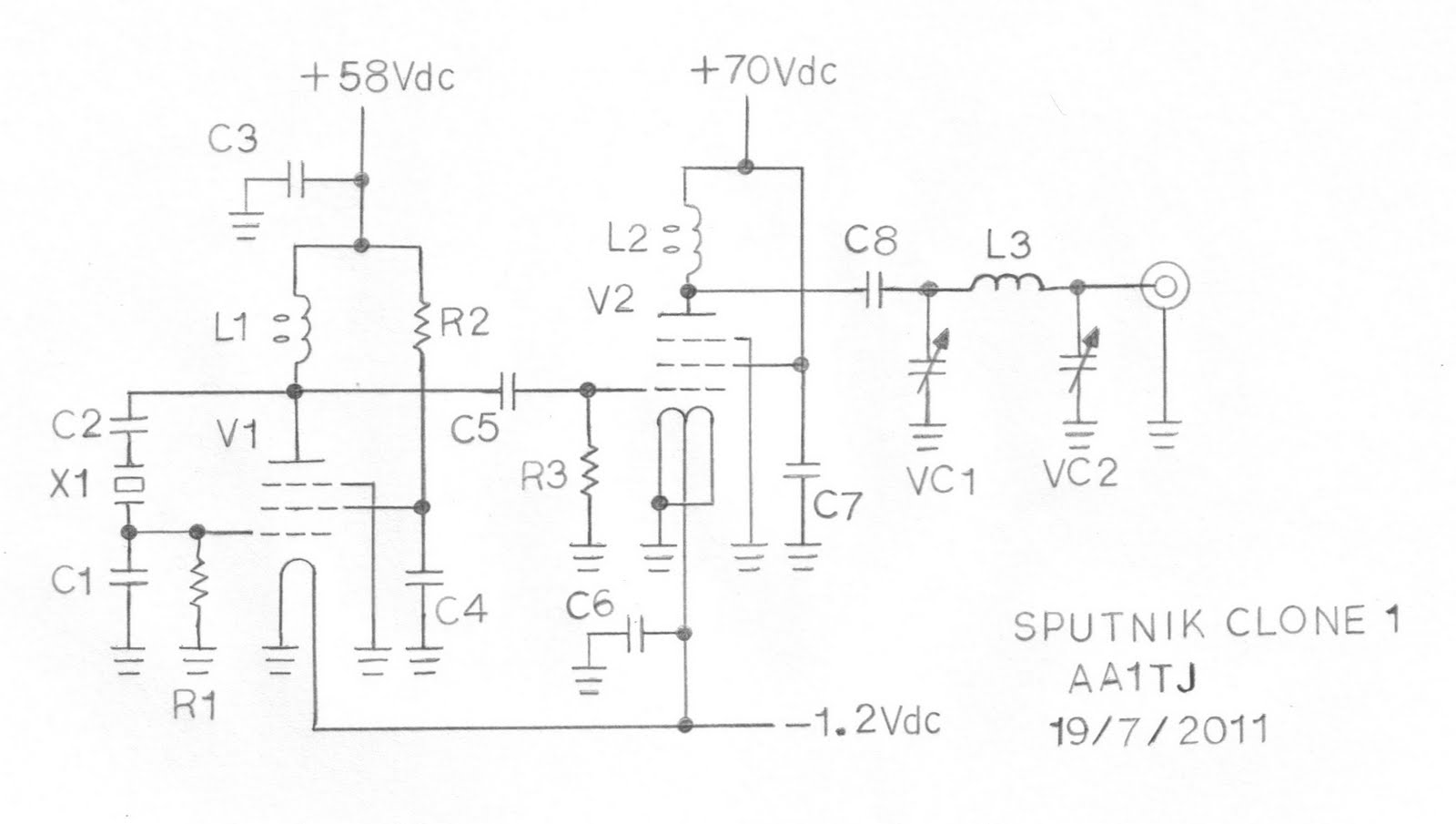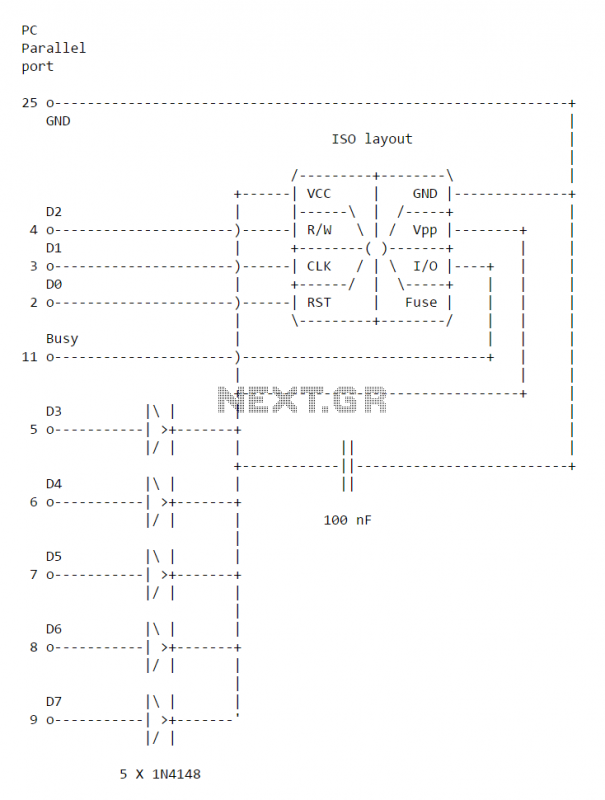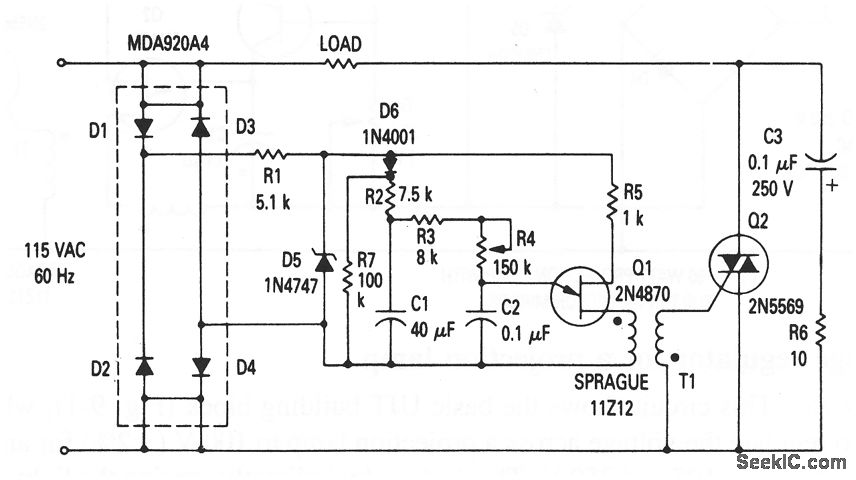
Spice and the art of preamplifier design
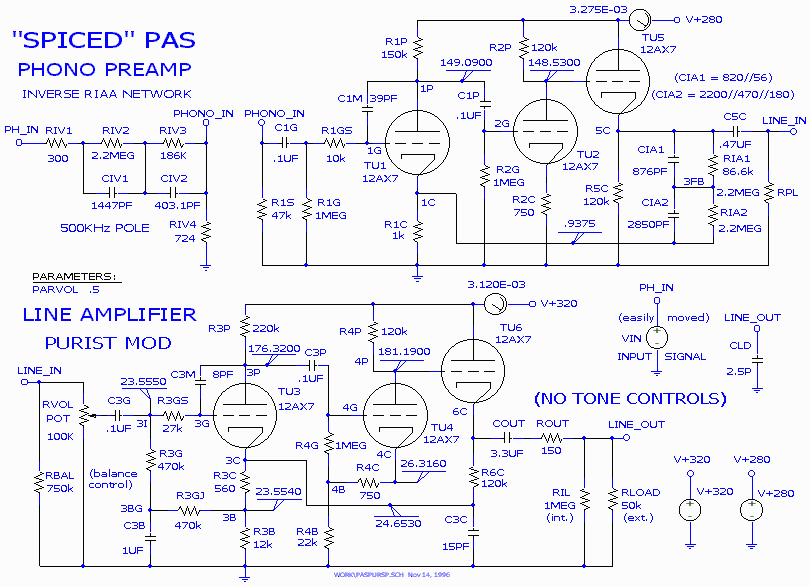
One of the main considerations in phono preamplifier design is the choice between active (feedback) and passive equalization. An ideal feedforward preamplifier for a moving magnet cartridge would provide approximately 40 dB of gain before the equalizer (more for low-output moving coil cartridges) and 20 dB of gain after it. However, achieving this is challenging with the three available sections of the 12AX7 tube in the phono preamplifier. Two sections could be configured in a mu-follower arrangement to achieve the required 40 dB gain, but since no extra gain is available for feedback, this stage's gain relies solely on the amplification factor of the lower 12AX7. This dependency could lead to channel imbalances if the tubes are not perfectly matched. Utilizing SPICE simulation, a feedback phono preamplifier was designed with excellent performance. The circuit topology is largely similar to the '94 modification, with some minor adjustments. DC coupling has been implemented in the negative feedback circuit. Although low-frequency feedback is minimal, eliminating unnecessary capacitors is beneficial. The positive feedback resistor (RPFB) between the gain stage cathodes has been removed, and resistor RPL has been added at the output to mitigate switching pops caused by the charging of output capacitor C5C. Most notably, a 33 pF capacitor (C1M) has been introduced between the grid (node 1G) and plate (node 1P) of the input stage TU1. This capacitor, known as a Miller capacitor due to the Miller effect, requires its capacitance to be multiplied by the closed-loop gain of the tube to determine the appropriate RC time constant. The capacitor stabilizes the feedback loop, which is critical given the high loop gain at elevated frequencies, reduces susceptibility to RF interference, and continues the RIAA roll-off at high frequencies. Its value is not critical, with a range of 22 to 47 pF being acceptable. Prior to its installation, certain Chinese 12AX7 tubes, which may exhibit high cathode-to-grid capacitance, demonstrated oscillation, indicated by a noticeable pop when switching the PAS to PHONO mode. The addition of C1M resolved this issue, resulting in improved sound quality from the Chinese tubes. Transient response issues in feedback phono preamplifiers can be effectively addressed with the inclusion of a Miller capacitor. C1M also enhanced the perceived silence during quiet passages, contributing to a more enjoyable listening experience. The RIAA network has been recalibrated to enhance frequency response accuracy and to increase feedback at low frequencies, thereby minimizing errors caused by tube variances. With the original design already providing ample gain for contemporary moving magnet cartridges, feedback can be improved by reducing circuit gain. The redesign commenced with a reduction of RIA2 from 4.7 MΩ to 2.2 MΩ. Other component values (RIA2, CIA1, CIA2) were determined through trial and error. The frequency response is nearly flat from 20 Hz to 100 kHz. Unless using the SPECIAL input for a microphone (which requires independent management), it is recommended to disconnect the wires connecting terminals 2, 3, 8, and 9 of the phono preamp board to the selector switch.
The phono preamplifier circuit operates by amplifying the low-level signal from the phono cartridge before it is processed by the equalizer. The choice of active feedback versus passive equalization significantly impacts the design and performance of the circuit. The use of a 12AX7 tube is common for its high gain and low noise characteristics, but the limitations of only three sections necessitate careful design considerations to achieve the desired gain levels.
In a typical configuration, the first stage utilizes two sections of the 12AX7 in a mu-follower arrangement, providing the necessary gain while maintaining low output impedance. The feedback network is designed to optimize the frequency response and minimize distortion. The introduction of the Miller capacitor (C1M) is a crucial enhancement, stabilizing the feedback loop and ensuring that the circuit remains free from oscillations, particularly at high frequencies where the loop gain is significantly high.
The adjustments made to the RIAA network play a vital role in ensuring that the frequency response remains accurate across the audio spectrum. By recalibrating the feedback and gain characteristics, the circuit can effectively accommodate variations in tube performance, ensuring consistent sound quality.
The overall design emphasizes reliability and performance, ensuring that the phono preamplifier can handle the nuances of various cartridge types while providing a clean and accurate audio signal. The careful selection of components and circuit topology reflects a commitment to high-fidelity audio reproduction, making this phono preamplifier a robust solution for audiophiles and music enthusiasts alike.One of the principal choices in phono preamplifier design is between active (feedback) and passive equalization. The ideal feedforward preamplifier for a moving magnet cartridge would have about 40dB gain prior to the equalizer (more for low-output moving coil cartridges) and 20dB gain following it This isn`t really practical with the three 12AX7 sections available for the phono preamplifier.
We could use two sections in a mu-follower configuration to get the 40dB gain, but since no extra gain is available for feedback, the gain of this stage is entirely dependent on the amplification factor of the lower 12AX7. This could result in an imbalance between channels if tubes are not absolutely identical. With the help of SPICE, we have been able to design a feedback phono preamplifier with flawless performance (above).
Except for a few small changes, the circuit topology is similar to the `94 mod. We now use dc-coupling in the negative feedback circuit. Since there is little feedback at low frequencies, this makes less difference than it does for the line amplifier, but eliminating an unnecessary capacitor never hurts. We have eliminated the positive feedback resistor (RPFB in Fig. 1) between the gain stage cathodes. We have added resistor RPL at the output to prevent switching pops that can result from charging of output capacitor C5C.
Most importantly, we have added 33 pF capacitor C1M between the grid (node 1G) and plate (node 1P) of input stage TU1. A capacitor connected between a grid and plate is called a Miller capacitor after the Miller effect: Its capacitance must be multiplied by the closed-loop gain of the tube to calculate the correct RC time constant.
This capacitor stabilizes the feedback loop (very important because of the extremely high loop gain at high frequencies), reduces sensitivity to RF interference, and continues the RIAA rolloff at very high frequencies. Its value is not critical: 22 to 47 pF is OK. Before it was added, certain Chinese 12AX7`s (which may have high cathode-to-grid capacitance) appeared to oscillate, as evidenced by a large pop not audible with other tubes when the PAS was switched to PHONO.
Adding C1M eliminated the pop, and the Chinese tubes now sound beautiful. Transient response problems in feedback phono preamplifiers can be completely eliminated by the addition of a Miller capacitor. C1M also gave the PAS a stronger subjective sense of silence in quiet passages: something that can be felt rather than measured.
The RIAA network has been recalculated to improve frequency response accuracy and to increase feedback at low frequencies so that errors due to differences between tubes are minimized. Since the original design has more then enough gain for modern moving magnet cartridges, we are able to increase feedback by reducing circuit gain.
The redesign started by reducing RIA2 from 4. 7MEG to 2. 2MEG. Other component values (RIA2, CIA1, CIA2) were determined by trial-and-error. Frequency response (below) is nearly ruler-flat from 20Hz to 100kHz. Unless you are using the SPECIAL input for a microphone (in which case you`re on your own) I recommend removing the wires that connect terminals 2, 3, 8, and 9 of the phono preamp board to the selector switch and removing the 🔗 External reference
The phono preamplifier circuit operates by amplifying the low-level signal from the phono cartridge before it is processed by the equalizer. The choice of active feedback versus passive equalization significantly impacts the design and performance of the circuit. The use of a 12AX7 tube is common for its high gain and low noise characteristics, but the limitations of only three sections necessitate careful design considerations to achieve the desired gain levels.
In a typical configuration, the first stage utilizes two sections of the 12AX7 in a mu-follower arrangement, providing the necessary gain while maintaining low output impedance. The feedback network is designed to optimize the frequency response and minimize distortion. The introduction of the Miller capacitor (C1M) is a crucial enhancement, stabilizing the feedback loop and ensuring that the circuit remains free from oscillations, particularly at high frequencies where the loop gain is significantly high.
The adjustments made to the RIAA network play a vital role in ensuring that the frequency response remains accurate across the audio spectrum. By recalibrating the feedback and gain characteristics, the circuit can effectively accommodate variations in tube performance, ensuring consistent sound quality.
The overall design emphasizes reliability and performance, ensuring that the phono preamplifier can handle the nuances of various cartridge types while providing a clean and accurate audio signal. The careful selection of components and circuit topology reflects a commitment to high-fidelity audio reproduction, making this phono preamplifier a robust solution for audiophiles and music enthusiasts alike.One of the principal choices in phono preamplifier design is between active (feedback) and passive equalization. The ideal feedforward preamplifier for a moving magnet cartridge would have about 40dB gain prior to the equalizer (more for low-output moving coil cartridges) and 20dB gain following it This isn`t really practical with the three 12AX7 sections available for the phono preamplifier.
We could use two sections in a mu-follower configuration to get the 40dB gain, but since no extra gain is available for feedback, the gain of this stage is entirely dependent on the amplification factor of the lower 12AX7. This could result in an imbalance between channels if tubes are not absolutely identical. With the help of SPICE, we have been able to design a feedback phono preamplifier with flawless performance (above).
Except for a few small changes, the circuit topology is similar to the `94 mod. We now use dc-coupling in the negative feedback circuit. Since there is little feedback at low frequencies, this makes less difference than it does for the line amplifier, but eliminating an unnecessary capacitor never hurts. We have eliminated the positive feedback resistor (RPFB in Fig. 1) between the gain stage cathodes. We have added resistor RPL at the output to prevent switching pops that can result from charging of output capacitor C5C.
Most importantly, we have added 33 pF capacitor C1M between the grid (node 1G) and plate (node 1P) of input stage TU1. A capacitor connected between a grid and plate is called a Miller capacitor after the Miller effect: Its capacitance must be multiplied by the closed-loop gain of the tube to calculate the correct RC time constant.
This capacitor stabilizes the feedback loop (very important because of the extremely high loop gain at high frequencies), reduces sensitivity to RF interference, and continues the RIAA rolloff at very high frequencies. Its value is not critical: 22 to 47 pF is OK. Before it was added, certain Chinese 12AX7`s (which may have high cathode-to-grid capacitance) appeared to oscillate, as evidenced by a large pop not audible with other tubes when the PAS was switched to PHONO.
Adding C1M eliminated the pop, and the Chinese tubes now sound beautiful. Transient response problems in feedback phono preamplifiers can be completely eliminated by the addition of a Miller capacitor. C1M also gave the PAS a stronger subjective sense of silence in quiet passages: something that can be felt rather than measured.
The RIAA network has been recalculated to improve frequency response accuracy and to increase feedback at low frequencies so that errors due to differences between tubes are minimized. Since the original design has more then enough gain for modern moving magnet cartridges, we are able to increase feedback by reducing circuit gain.
The redesign started by reducing RIA2 from 4. 7MEG to 2. 2MEG. Other component values (RIA2, CIA1, CIA2) were determined by trial-and-error. Frequency response (below) is nearly ruler-flat from 20Hz to 100kHz. Unless you are using the SPECIAL input for a microphone (in which case you`re on your own) I recommend removing the wires that connect terminals 2, 3, 8, and 9 of the phono preamp board to the selector switch and removing the 🔗 External reference

